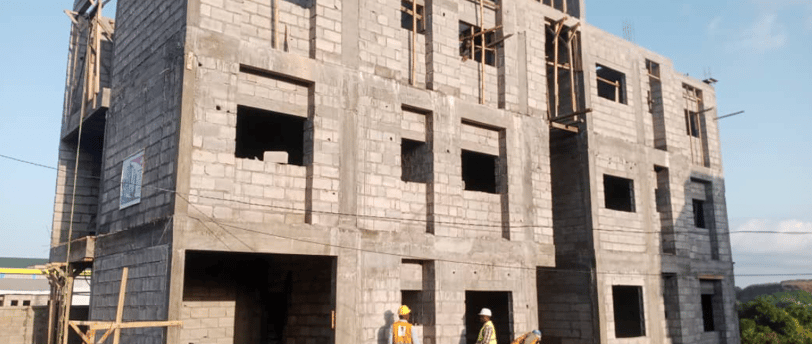Essential Steps to Start Your Home Construction Project with Confidence


Understanding Your Vision
Before initiating a home construction project, it is imperative to have a well-defined vision that reflects your unique preferences and needs. Articulating your ideas is the first step toward translating your aspirations into actionable plans. Begin by brainstorming what you envision for your future home. Consider factors such as the number of rooms, layout preferences, and specific functionalities that cater to your lifestyle.
In this phase, exploring various design styles can significantly influence the outcome of your project. From contemporary to rustic, each style comes with its own charm and practicality. To help clarify your vision, consider browsing design magazines or online platforms that showcase a myriad of home designs. This exploration not only provides inspiration but also helps you identify specific features that resonate with your personal taste.
Once you have gathered ideas, it is crucial to prioritize your needs and wants. Make a list, categorizing elements into 'essentials' and 'desirables.' This process will aid in making informed decisions as you progress through the construction phase. For instance, while a spacious kitchen with modern amenities may be an essential requirement, a luxury bathtub might be categorized under desirables. Recognizing these priorities will also assist in budgeting and resource allocation throughout the project.
Ultimately, having a well-thought-out plan is vital, ensuring that every aspect of your construction project aligns with both personal and family requirements. Engage family members in discussions about their needs and preferences, as this collaborative approach fosters a sense of ownership and satisfaction in the final outcome. This investment of time and effort in understanding your vision lays the groundwork for a successful home construction journey.
Budgeting for Your Project
Creating a comprehensive budget is vital for the success of any home construction project. It serves as the financial blueprint, allowing you to allocate resources effectively, maintain control over expenses, and avoid potential pitfalls during the construction process. The budgeting process begins with a detailed assessment of all potential costs associated with the project, including materials, labor, and permits.
When estimating material costs, it is essential to obtain quotes from multiple suppliers to compare prices and quality. Raw materials—such as timber, concrete, roofing, and fixtures—can vary significantly in price based on quality and availability. Similarly, labor costs can fluctuate based on the project's complexity and the hourly rates of contractors. Engaging with reputable contractors and discussing payment structures will help clarify labor expenses within your budget.
Permits are another critical component of budgeting. Depending on your location, specific building permits may be required, and associated fees can add up quickly. It is advisable to consult with your local jurisdiction to ascertain the necessary permits and their costs to avoid underestimating this aspect of the project.
No construction budget would be complete without accounting for unforeseen expenses. Incorporating a contingency fund—typically 10% to 20% of the overall budget—provides a financial cushion for unexpected challenges that may arise during the project. This fund allows you to handle complications without derailing your timeline or exceeding your budget.
If financing becomes necessary, consider exploring options such as home equity loans, construction loans, or personal loans. Understanding the different financing options available can provide you with the capital needed to move forward confidently with your home construction project. By carefully budgeting and planning for every stage of the project, you lay the groundwork for a successful and efficient construction process.
Obtaining Necessary Permits
Starting a home construction project necessitates the acquisition of various permits to ensure compliance with local laws and regulations. These permits are essential as they grant official approval for the construction work to commence, encompassing aspects such as zoning, building codes, and safety standards. The types of permits commonly required include building permits, electrical permits, plumbing permits, and mechanical permits, among others. Each type addresses specific facets of construction and helps safeguard the quality and safety of the project.
The process for securing these permits can vary significantly based on locality. Typically, the steps involve submitting detailed construction plans, specifications, and possibly, environmental assessments to the local building department. It is advisable to engage professionals, such as architects or licensed contractors, who are familiar with local regulations to prepare the necessary documentation efficiently. This step can save valuable time and reduce the likelihood of complications during the approval process.
Failing to obtain the required permits can lead to severe repercussions, including fines, project delays, or even the mandated dismantling of non-compliant work. Local authorities often have stringent measures in place to ensure that construction adheres to established regulations, which helps maintain safety and architectural standards within communities. Engaging early with local officials can facilitate smoother navigation through this bureaucratic landscape. Early communication can provide insights into specific requirements, fees, and timelines, ensuring that potential hurdles are addressed proactively.
Furthermore, establishing a rapport with the local authority can be advantageous. Attending public meetings, proactively asking for guidance, and developing a respectful working relationship with building officials can foster constructive dialogue, thus streamlining the process. With thorough preparation and an understanding of the permitting landscape, homeowners can approach their construction projects with greater confidence and security.
Choosing the Right Contractors
Choosing the right contractors is one of the most crucial steps in ensuring the successful completion of your home construction project. The selection process should be thorough and well-structured to mitigate risks associated with poor workmanship or unprofessional behavior. Start by compiling a list of potential contractors through recommendations from friends, family, or online reviews. It is essential to consider contractors who have a reputation for reliability and quality in their work.
Once you have a preliminary list, the next step is to verify the credentials of each contractor. Ensure they hold the necessary licenses and insurance. This not only protects you but also indicates that the contractor adheres to the necessary building codes and regulations in your area. A quick check with your local regulatory body can confirm the contractor's status. Additionally, it is advisable to inquire about their experience in the type of construction work you require. Specialization can significantly influence the outcome of your project.
Conducting interviews with selected contractors is also important. This phase presents an opportunity for you to assess their communication skills and professionalism, both crucial for a successful partnership. Prepare questions regarding their project management strategies, estimated timelines, and contingency plans for potential issues. Pay attention to the contractor's ability to explain their quotes and the materials they intend to use.
Lastly, evaluating previous projects completed by potential contractors can provide insights into their capabilities and style. Ask for a portfolio or visit past job sites if possible. This will help you gauge the quality of their work and see whether it aligns with your vision. Clear communication and comprehension of contract terms will further ensure that all expectations are met, setting a solid foundation for your home construction journey.
Selecting Quality Materials
When embarking on a home construction project, selecting quality materials is a crucial step that can substantially impact the durability, aesthetic appeal, and overall success of the build. Homeowners must carefully evaluate their choices based on several key factors, including budget, sustainability, and personal style preferences.
Budget is often a primary concern when selecting construction materials. While it might be tempting to opt for the cheapest options available, investing in higher quality materials can yield long-term savings and enhance the lifespan of the structure. Durable materials often require less maintenance and replacement, which can reduce overall costs in the future. For example, while vinyl siding may have a lower initial cost than fiber cement, the latter offers superior durability and may ultimately save homeowners on repairs.
Sustainability has become an increasingly important criterion for many homeowners. Environmentally friendly materials not only contribute to a lower carbon footprint but can also promote healthier living conditions. Options such as reclaimed wood, recycled metal, and bamboo are excellent choices that marry aesthetics with eco-friendliness. Furthermore, sourcing from local suppliers can significantly cut down on transportation emissions, contributing to a more sustainable construction process.
Finally, style preference must not be overlooked. The materials selected should reflect the desired architectural style and personal tastes of the homeowner. From traditional brick to modern glass façades, each material carries unique characteristics that can enhance the overall design of the home. It is advisable to research various materials' pros and cons and consult with professionals to ensure informed decisions are made.
In conclusion, selecting quality materials for your home construction project is a multifaceted process that requires careful consideration of budget, sustainability, and style. By prioritizing these elements, homeowners can achieve a balanced approach that ensures both functionality and aesthetic appeal in their new homes.
Establishing a Timeline
Creating a realistic timeline is crucial for the successful execution of a home construction project. A well-structured timeline not only keeps the project on track but also serves as a guiding framework for managing various phases of the construction process. To begin, it is essential to identify key milestones associated with the different stages of construction. For instance, milestones may include the completion of the foundation, framing, roofing, and final inspections. By breaking down the project into these manageable phases, homeowners can more effectively estimate the duration required for each stage.
When establishing key milestones, it is also important to factor in estimated completion dates. A detailed timeline should reflect not only when work is expected to commence but also when each milestone is anticipated to be reached. Construction schedules often involve collaboration among various contractors, suppliers, and subcontractors, which can impact the overall timeline. Therefore, communication with all parties involved is vital to acquire accurate estimates and set realistic completion dates.
Furthermore, potential delays must be taken into account during the planning phase. Construction projects are often susceptible to unanticipated issues such as adverse weather conditions, supply chain interruptions, or changes in design, which can be detrimental to the timeline. To mitigate the effects of these delays, it is advisable to build some flexibility into the schedule. This can be achieved by allocating buffer periods between milestones. Flexibility in project planning allows homeowners to adapt to unforeseen circumstances without derailing the entire construction process.
In conclusion, establishing a timeline that encompasses key milestones, estimated completion dates, and provisions for potential delays is fundamental in ensuring the success of a home construction project. A thoughtful and adaptable approach to scheduling can greatly enhance project management and confidence in the construction journey.
Staying Involved and Communicative
Effective communication and active involvement are crucial elements in the home construction process. They play a significant role in ensuring that the project aligns with the homeowner's vision, expectations, and timelines. From the initial planning phase to the final walkthrough, homeowners should engage regularly with their contractors and team to foster a collaborative environment. One critical best practice is to establish a clear line of communication from the outset. This can include scheduled meetings, phone calls, and email updates, allowing both parties to stay informed about the project's progress and any emerging concerns.
Regularly monitoring the progress of the construction work is essential for maintaining alignment with the project goals. Homeowners are encouraged to conduct site visits, as this provides opportunities to inspect the quality of the work and ensure compliance with architectural plans. These visits also allow homeowners to address any issues or discrepancies promptly, reducing the likelihood of costly delays or misunderstandings. Documenting observations during these visits can be beneficial when discussing findings with contractors. Keeping thorough notes can help clarify expectations and services, ensuring that everyone remains on the same page throughout the construction process.
Additionally, it is important to encourage an open dialogue with the construction team. Homeowners should feel comfortable asking questions and expressing their concerns. Establishing a culture of transparency can lead to better decision-making and quicker resolutions when complications arise. Issues are more easily avoided when communication is ongoing, allowing for timely adjustments and refinements. Regular check-ins, whether weekly or bi-weekly, can be a productive way to evaluate progress and re-align the project goals if necessary. Overall, staying involved and communicative during the construction process not only enhances the project's outcome but also cultivates a positive working relationship between homeowners and contractors.


